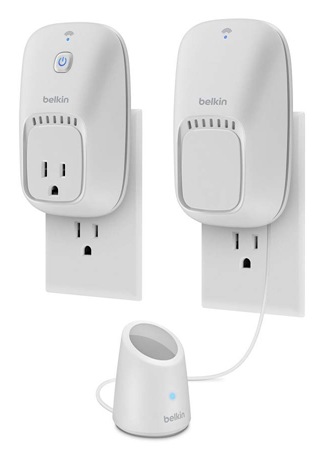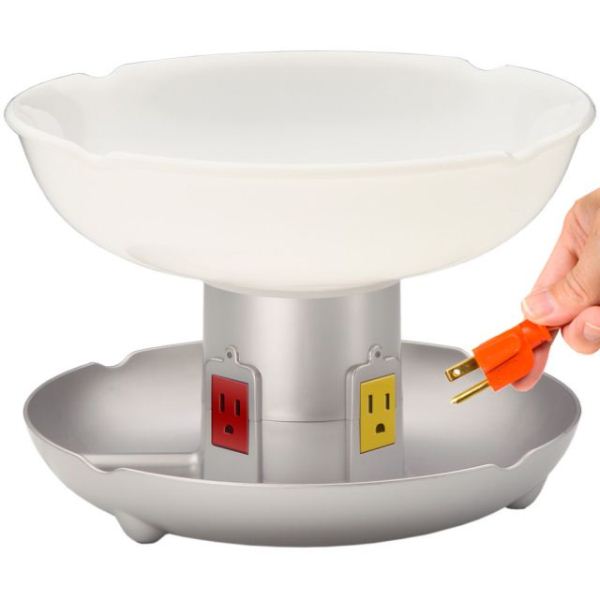Home Automation and the 'Internet of Things'
by Ganesh T S on October 4, 2012 10:30 AM EST- Posted in
- Gadgets
- Home Automation
- Wi-Fi
Power switching is a simple home automation application in which a device can be powered up or down at the socket level remotely. Simple Wi-Fi switches such as the NetRC1 have been around since early 2010. One of the first mainstream companies to enter into this space was Belkin. In this section, we will take a look at two interesting Wi-Fi based power switches, the Belkin WeMo kits and Visible Energy’s offerings.
Belkin WeMo
Belkin’s WeMo lineup consists of two offerings, the plain WeMo Wi-Fi controlled switch ($50) and the WeMo switch combined with a motion sensor ($100). Currently, only an iOS app is available for controlling the switch.

A web-service called ‘If This Then That’ works with these switches and allows bidirectional reaction to events. For example, a event triggering the motion sensor on a particular unit could be used to generate an email message. Similarly, an event happening on a website (say, a weather channel website indicating that the sun has set at a particular location) can trigger a particular switch on.
Currently, the device seems to be recommendable only to consumers in the Apple ecosystem because of the absence of an Android app. It is not clear whether the unit is accessible from a browser on the local network in the case that there is no access to the Internet and an iOS device is not available. Similar to the walled garden being created by Nest, Belkin also refuses to document the APIs officially. However, this has not prevented the communication methods from getting exposed. The concerns that I voiced in the earlier section regarding Nest warrant a repetition here too. Belkin does plan to add more Wi-Fi enabled home automation devices such as door locks and light bulbs to this lineup. That is a positive compared to having a dedicated app with a different UI for the thermostat alone. In any case, home automation system adopters should try to ensure that the components being put in have well-documented control interfaces.
Visible Energy
My search for an economical and open Wi-Fi power switch ended when I spotted Visible Energy’s UFO Power Center and Monostrip. In addition to the ability to power the outlets up and down over Wi-Fi, they also provide real time power usage feedback. Like the WeMo, only an iOS app is available right now. However, web access is also provided using the Visible Energy Web Dashboard. The four-outlet UFO Power Center comes in at $130, while the two-socket Monostrip comes in at $49. Visible Energy also sells a version of the Monostrip with temperature and humidity sensors at $130.
The UFO power center has a strange industrial design, while the Monostrip is a little more conventional in nature. While we are looking at the two units from a Home Automation perspective, the company stresses the fact that the products are more about conserving electricity and creating a user friendly energy management system.
The energy management goals make it necessary for the product to have real time power monitoring. This is a very useful feature (actually, the primary feature) present in Visible Energy’s products when compared to other Wi-Fi enabled power switches. Power consumption is calculated and refreshed every second. Energy usage is calculated 50 times a second and the data is recorded at 5 minute intervals.
The real clincher is the availability of extensive developer documentation for accessing the energy / power data and controlling the units. This makes it easy for third parties to create custom interfaces in a home automation setting.












54 Comments
View All Comments
AshuJoshi - Thursday, October 4, 2012 - link
Hi Ganesh,Very extensive article and well covered. A few thoughts, and I think you or your readers have already touched upon this:
1. Bluetooth LE / 4.0 - is pretty important as well. One because many medical devices have adopted BT, and not Zigbee or ZWave or WiFi.
2. ZWave is very popular BUT my concern is that it is controlled by one company.
3. SEP 2.0 is going to be a very important move forward especially because it will work with WiFi, HPAV, and Zigbee.
4. Kickstarter - I noticed that you picked some projects. I think there are three segments to Home Automation - DIY, Luxury and NOW Managed (as provided by the likes of Comcast). Luxury traditionally belonged to the likes of Creston but Control4 is playing a major disruptor now. For the DIY segment - Kickstarter has changed the world. Here is my post on the # of projects on Kickstarter for HA - http://bit.ly/Q02Mk2
5. Service Providers are getting very active in this space - Comcast, Rogers, AT&T, DT etc.
AshuJoshi - Thursday, October 4, 2012 - link
WiFi appears to be a popular choice for powered appliances and as the article talks about Semiconductor providers such as Marvell are providing compelling solutions. The challenge is that every implementation especially if it is from a different semi partner - its implementation in SW is different. That is there is no standard or specification to discover devices on WiFi - each implementation could be different. I am contrasting this with Zigbee because Zigbee has a well-defined protocol on how devices are discovered and controlled by category (Zigbee has its own terminology for all of this).davegravy - Friday, October 5, 2012 - link
Lots of talk about hardware, and a bit of discussion about controllers and host software, but there isn't a lot of software out there that's provides a bridge between all the different protocols and the central brain/logic essential to the smart home.I've been using LinuxMCE (free, open-source) and have been following their development for the past while. Not yet for the technically faint of heart, but there ARE device templates for a large number of different protocols (Z-wave, Insteon, KNX, RS232, IR, X10, various ethernet devices, etc) allowing you to control pretty much any type of HA device. It also controls media and VOIP telecom in your house. The end result is a fully integrated solution between all devices in your home.
Example: Someone rings the door bell. Your porch light turns on (if it is after sundown), your IP cam turns on, its video feed is forwarded to your mobile phone, and (if it knows you are home because your security system is not armed, or by other logic) to the various TVs around your house after powering them on. The video is also recorded to your server. If you were watching TV during this event, it pauses your feed and to show you the front door IP cam.
The possibilities are truly endless with this software, and I have to give it a plug here.
ntspam - Friday, October 5, 2012 - link
I was really hoping that google putting its software creating talent behind home automation was finally going to kick this market mainstream. What a disappointment.jed22281 - Sunday, October 7, 2012 - link
These guys have been ahead of the curve in this area for 4yrs+ now:http://openremote.org/display/HOME/OpenRemote
Truly open, ubiquitous, Home Automation solutions, shame they didn't get a mention.
taltamir - Sunday, October 7, 2012 - link
WiFi controlled lights, thermostat, and power... now your home can be hacked in ways that holliwood only dreamed of.geraldt - Friday, October 12, 2012 - link
Nice article on one of my obsessions. I so want WiFi to be the household communications protocol (actually TcpIp with any mix of wireless, wired CAT5, powerline Ethernet etc. that may be appropriate depending on the devices and controllers).I want a ubiquitous open standard that is well understood. I want two-way comm. I want sufficient bandwidth for video. I want security. I want all my current and future smart devices (desktop, tablet, smart phone, Raspberry Pi, robots, etc.) to be able to participate. I want that common infrastructure so I can incrementally add devices from various manufacturers. I also want the option of writing my own code in smart controllers e.g. PC.
One point the article kind of makes is that common comm protocol is not enough, you need a higher level API for each device that is well documented.
p.s. I think the technology in the new Kindle Paperwhite (touch, front lit, very low power, wifi) could be packaged into a great HA and AV remote. No video is a drawback for some applications like answering the door but still pictures at 1 fps might be fine.
xSaintSinnerx - Wednesday, November 7, 2012 - link
Maybe I'm mistaken but few years ago Microsoft was talking about getting involved in HA business. I believe Gates was talking about it too. MS could easily create standard for HA Wi-Fi and become leader on the market with hardware and software in Windows RT or 8 environment.can you imagine possibilities ... BSoD on your thermostat.
Nomzam - Thursday, November 8, 2012 - link
Yeah the idea and performance are best but there is a security risk of internet.<a href="http://www.squidoo.com/iport-launchport-inductive-... Automation</a>
space31 - Wednesday, August 7, 2013 - link
Some new web remonte power hère : http://www.wifipower.fr